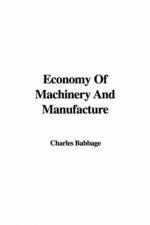81. Of all the operations of mechanical art, that of turning is the most perfect. If two surfaces are worked against each other, whatever may have been their figure at the commencement, there exists a tendency in them both to become portions of spheres. Either of them may become convex, and the other concave, with various degrees of curvature. A plane surface is the line of separation between convexity and concavity, and is most difficult to hit; it is more easy to make a good circle than to produce a straight line. A similar difficulty takes place in figuring specula for telescopes; the parabola is the surface which separates the hyperbolic from the elliptic figure, and is the most difficult to form. If a spindle, not cylindrical at its end, be pressed into a hole not circular, and kept constantly turning, there is a tendency in these two bodies so situated to become conical, or to have circular sections. If a triangular-pointed piece of iron be worked round in a circular hole the edges will gradually wear, and it will become conical. These facts, if they do not explain, at least illustrate the principles on which the excellence of work formed in the lathe depends.
Chapter 11
Of Copying
82. The two last-mentioned sources of excellence in the work produced by machinery depend on a principle which pervades a very large portion of all manufactures, and is one upon which the cheapness of the articles produced seems greatly to depend. The principle alluded to is that of copying, taken in its most extensive sense. Almost unlimited pains are, in some instances, bestowed on the original, from which a series of copies is to be produced; and the larger the number of these copies, the more care and pains can the manufacturer afford to lavish upon the original. It may thus happen, that the instrument or tool actually producing the work, shall cost five or even ten thousand times the price of each individual specimen of its power.
As the system of copying is of so much importance, and of such extensive use in the arts, it will be convenient to classify a considerable number of those processes in which it is employed. The following enumeration however is not offered as a complete list; and the explanations are restricted to the shortest possible detail which is consistent with a due regard to making the subject intelligible.
Operations of copying are effected under the following circumstances:
by printing from cavities by stamping by printing from surface by punching by casting with elongation by moulding with altered dimensions
Of printing from cavities
83. The art of printing, in all its numerous departments, is essentially an art of copying. Under its two great divisions, printing from hollow lines, as in copperplate, and printing from surface, as in block printing, are comprised numerous arts.




